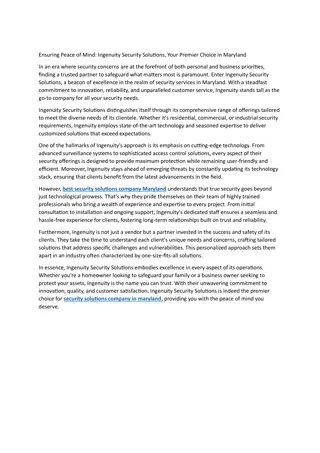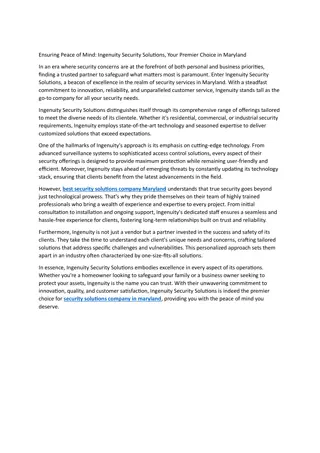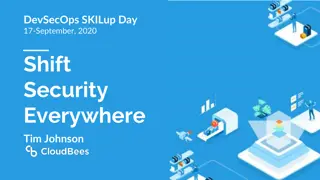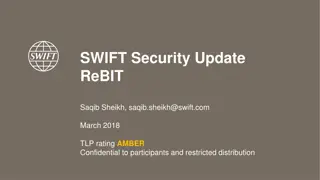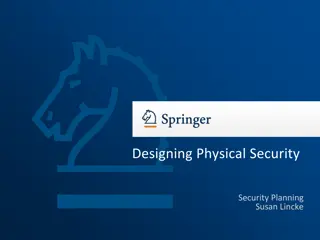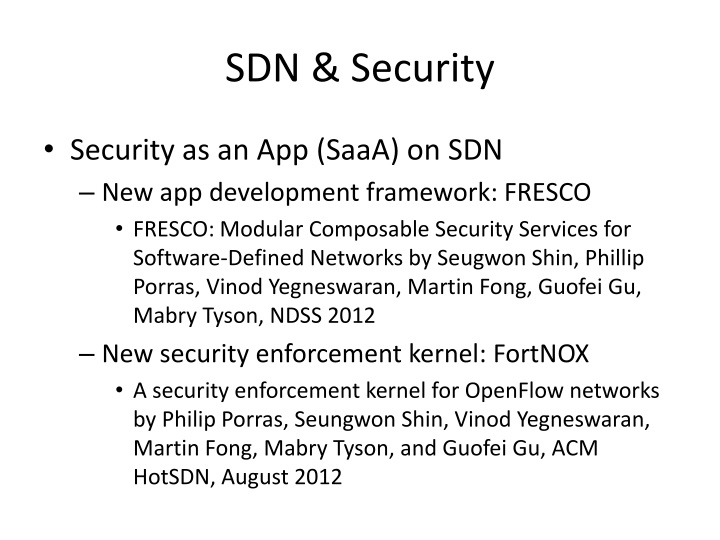
Innovative Security Applications in Software-Defined Networking
Explore the realm of Software-Defined Networking (SDN) and the integration of security mechanisms as applications within this framework. Learn about pioneering research and advancements in SDN security, including modular security services and security enforcement kernels. Discover the unique opportunities SDN presents for centralized network control and the development of security applications. Delve into the implications of SDN on reducing energy in data centers, WAN management, VM migration, and the emergence of Security as an App (SaaA).
Download Presentation

Please find below an Image/Link to download the presentation.
The content on the website is provided AS IS for your information and personal use only. It may not be sold, licensed, or shared on other websites without obtaining consent from the author. If you encounter any issues during the download, it is possible that the publisher has removed the file from their server.
You are allowed to download the files provided on this website for personal or commercial use, subject to the condition that they are used lawfully. All files are the property of their respective owners.
The content on the website is provided AS IS for your information and personal use only. It may not be sold, licensed, or shared on other websites without obtaining consent from the author.
E N D
Presentation Transcript
SDN & Security Security as an App (SaaA) on SDN New app development framework: FRESCO FRESCO: Modular Composable Security Services for Software-Defined Networks by Seugwon Shin, Phillip Porras, Vinod Yegneswaran, Martin Fong, Guofei Gu, Mabry Tyson, NDSS 2012 New security enforcement kernel: FortNOX A security enforcement kernel for OpenFlow networks by Philip Porras, Seungwon Shin, Vinod Yegneswaran, Martin Fong, Mabry Tyson, and Guofei Gu, ACM HotSDN, August 2012
Problems of Legacy Network Devices Too complicated Control plane is implemented with complicated S/W and ASIC Closed platform Vendor specific Hard to modify (nearly impossible) Hard to add new functionalities Source: G. Gu, et al, Texas A&M &SRI
Software Defined Networking (SDN) Three layer Application layer Application part of control layer Implement logic for flow control Control layer Kernel part of control layer Run applications to control network flows Infrastructure layer Data plane Network switch or router SDN architecture from ONF 3
OpenFlow Architecture OpenFlow Switch specification application OpenFlow Switch PC controller Secure Channel sw A controller application can enforce any flow rules to network switches Flow Table hw 4 From openflow tutorial
Unique opportunity with SDN Everything is controlled through the logically centralized network OS Can introduce security mechanism here! Think of NFV
Killer Applications of SDN? Reducing Energy in Data Center Networks (load balancing) WAN VM Migration How about security? We are going to talk about this, more specifically: Security as an App (SaaA) Security as a Service (SaaS) Source: G. Gu, et al, Texas A&M &SRI
Security as an App SDN naturally has an application layer Security functions can be apps on top of SDN/ networking OS Firewall Scan detection DDoS detection Intrusion detection/prevention Why SaaA? Cost efficiency Easy deployment/maintenance Rich, flexible network control Source: G. Gu, et al, Texas A&M &SRI
Challenges and New Contributions It is not easy to develop security apps FRESCO: a new app development framework for modular, composable security services It is not secure when running buggy/vulnerable/ multiple security apps (e.g., policy conflict/bypass) FortNOX: a new security enforcement kernel Source: G. Gu, et al, Texas A&M &SRI
FRESCO: Framework for Enabling Security Controls in OpenFlow networks
What is FRESCO? A new framework Enables to compose diverse network security functions easily (bycombining multiple modules) Enables to create own network security functions easily (without requiring additional H/Ws openflow provides all necessary functionality) Enables to deploy network security functions easily and dynamically (without modifying the underlying network architecture) Enable to add more intelligence to current network security functions Source: G. Gu, et al, Texas A&M &SRI
11/17/14 Source: G. Gu, et al, Texas A&M &SRI
FRESCO Overall Operation Monitor OpenFlow switches Create Modules Load Modules Run Modules Answer from NOX Notify NOX of loading FRESCO modules Source: G. Gu, et al, Texas A&M &SRI
FRESCO application layer FRESCO have a number of internal NOX python security modules. Developers use the FRESCO script language to instantiate and defined the interactions between the modules security application. FRESCO security application is triggered by input events. 14
FRESCO Modular Design event parameter input output action Module k e y values F-DB instance Source: G. Gu, et al, Texas A&M &SRI
FRESCO development environment Script-to-module translation: Script-to-module translation abstracting the implementation complexities of producing OF controller extension. Database management collects network and switch state information to be shared by all security apps. Event management notifies an instance about the occurrence of predefined events. Instance execution authenticated to run with authority granted at registration.
FRESCO resource controller Make sure the resources (flow table entry) are available at switches Evict flow table entry if necessary Two functions Switch monitor Garbage collection clean up flow table.
FRESCO Script Language Goal Define interfaces, actions, and parameters Connect multiple modules Similar to C/C++ function, start with { and end with } Format Instance name (# of input) (# of output) denotes the module name and the number of input and output variables INPUT: a1,a2, denotes input items for a module an may be set of flows, packets or integer values OUTPUT: b1,b2, denotes output items for a module bn may be set of flows, packets or integer values PARAMETER: c1,c2, denotes configuration values of a module cn may be real numbers or strings EVENT: d1,d2, denotes events that will be delivered to a module dn may be any predefined string ACTION : condition ; action, denotes actions that will be performed based on condition Source: G. Gu, et al, Texas A&M &SRI
A working example Reflector net detect an active malicious scanner, and reprogram the switch data plan to redirect the scanner s flow into a remote honeynet.
Simple Working Example: Reflector Net do_redirect (2) (0) { TYPE: ActionHandler EVENT:PUSH INPUT:SRC_IP, scan_result OUTPUT: - PARAMETER: - ACTION: scan_result == 1? REDIRECT: FORWARD /* if scan_result equals 1, redirect; otherwise, forward */ } find_scan (1) (2) { TYPE: ScanDetector EVENT:TCP_CONNECTION_FAIL INPUT: SRC_IP OUTPUT: SRC_IP, scan_result PARAMETER: 5 ACTION: - /* no actions are defined */ } Module 1 Module 2 Source: G. Gu, et al, Texas A&M &SRI
More Tarpits White Holes Scan detector P2P detector (P2P Plotter) Botnet detector (BotMiner) Over 90% reduction in lines of code compared with their standard implementations Already include more than 16 commonly reusable modules (expending over time) Source: G. Gu, et al, Texas A&M &SRI
FortNOX: A Security Enforcement Kernel for OpenFlow Source: G. Gu, et al, Texas A&M &SRI
New Threat SDN apps can compete, contradict, override one another, incorporate vulnerabilities Worst case: an adversary can use a vulnerable and deterministic SDN app to control the state of all SDN switches in the network Source: G. Gu, et al, Texas A&M &SRI
SDN/OpenFlow Evasion Scenario: enforcement challenge . Dynamic Flow Tunneling Source: G. Gu, et al, Texas A&M &SRI
Prerequisites for a Secure OpenFlow Platform Must be resilient to Vulnerabilities in OF applications Malicious code in 3rd party OF apps Complex interaction that arise between OF app interactions State inconsistencies due to switch garbage collection or policy coordination across distributed switches Sophisticated OF applications that employ packet modification actions Adversaries who might directly target our security services to harm the network Source: G. Gu, et al, Texas A&M &SRI
FORNOX NOX+non-bypassable policy-based flow rule enforcement. Once a flow rule is inserted to FortNOX by a security application, no peer OF application can insert flow rules that conflict with the rule. Role-based authorization Rule conflict detection Security directive translation Source: G. Gu, et al, Texas A&M &SRI
Classic NOX Architecture PY OF Apps Python SWIG Native C OF Apps Send_OpenFlow_Command() NOX 29 Source: G. Gu, et al, Texas A&M &SRI Software Defined Networking (COMS 6998-10)
FortNOX Architecture Separate Process Native C OF Apps PY OF Apps Security Apps OF IPC Proxy Actuator Python SWIG Directive Translator IPC Interface Aggregate Flow Table FT_Send_OpenFlow_Command Operator Rules Role-based Source Auth OF Mod Commands Add (conflict enforced) Modify (conflict enforced) Delete (priority enforced) State Table Manager SECURITY Rules Conflict Analyzer Switch Callback Tracking OF App Rules FortNOX Switch Callback tracking Source: G. Gu, et al, Texas A&M &SRI
Role based source authentication Human administrator (high priority) Security applications Non-security OF applications (low) Roles implemented with a digital signature scheme.
Conflict detection/resolution Alias set rule reduction Rules are converted into an internal representation called alias reduced rules Resolution Based on the priority of the rule.
Summary of FortNOX FortNOX A new security enforcement kernel for OF networks Role-based Authorization Rule-Authentication Conflict Detection and Resolution Security Directive Translation A Security Enforcement Kernel for OpenFlow Networks . HotSDN 12 Source: G. Gu, et al, Texas A&M &SRI










